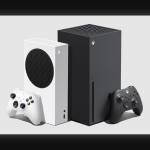Ah, Radeon. At a time where AMD was making massive leaps forward with their Zen CPUs, their graphics division was struggling to make any meaningful strides. Polaris only offered mid-range performance and was refreshed beyond comprehension, and Vega was mostly a hot mess. The RDNA-based Navi cards were reworked from the group up, and were competitive mid-range cards, but were plagued by driver issues until very recently. And, we never got high-performance variants of the Navi 1X chips.
With the RDNA 2-based Navi 21 chips, it seems like AMD has finally worked out the kinks of Navi 1X and put forward graphics cards that compete with even the highest-end cards from the competitors.
RDNA 2
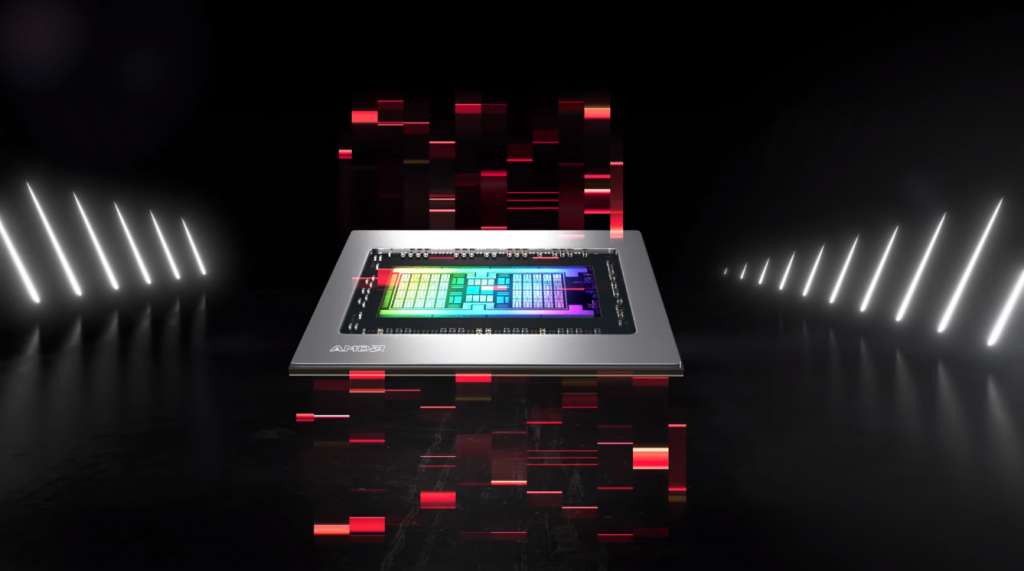
AMD has executed on it’s perf/watt increase promises again. This time, we see a 54% increase v/s RDNA, which is 4% higher than their target. And with the flagship 6900 XT, they’ve managed an impressive 65% uplift. This uplift is attributed to three main factors: Higher frequencies (~30% more), Power efficiency improvements (~30% more), and Performance per clock enhancements with Infinity Cache.
The new Infinity Cache seems to provide a majority of that uplift. It’s similar to the L3 cache on their Zen CPUs, and Navi 21 has 128MB of it. On the surface level, this is supposed to alleviate DRAM bottlenecks by enabling the GPU to fetch data quickly from the cache instead. This is AMD’s solution to avoid using the power-hungry GDDR6X modules, seen on the RTX 300 series from Nvidia. Using regular 256-bit GDDR6 memory along with Infinity cache gives the architecture 2.17X the memory bandwidth (compared to 384-bit GDDR6), while using slightly less power.
RDNA 2 also features ray-tracing accelerator cores. Each compute unit gets one of these cores, which finally enables hardware-based ray-tracing (DirectX Ray Tracing) on AMD cards. As the architecture supports DirectX 12 Ultimate, it also supports other features like Variable Rate Shading, Mesh Shaders, and Sampler Feedback.
“Big Navi” is here
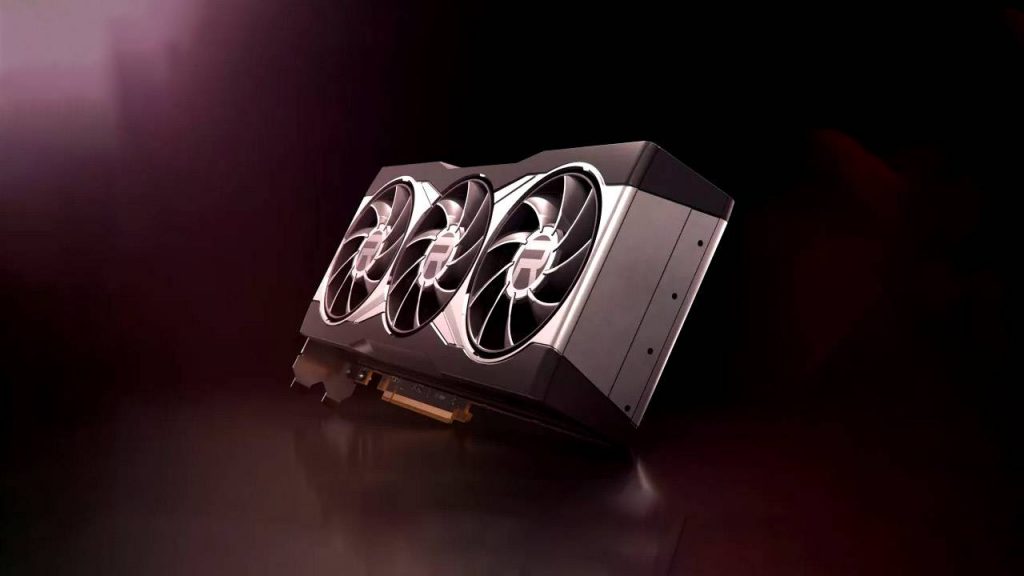
AMD has announced 3 new graphics cards based on the Navi 21 die: the Radeon RX 6800, 6800 XT, and 6900 XT. All of them sport an identical shroud design (seen above), but the RX 6800 will be physically smaller (2-slot) compared to the 6800XT and 6900XT, which are larger (2.5-slot) and of the same size. All cards require 2x 8-pin power connectors, and there might be 3x 8-pin variants from board partners.
Radeon RX 6800
- 60 Compute Units & Ray accelerators
- 16GB of 256-bit GDDR6 (512 GB/s bandwidth)
- 1815Mhz Game Clock / 2105Mhz Boost Clock
- 128MB Infinity Cache
- 650W Recommended PSU
- 250W TDP
- $579
The RX 6800 is the lowest variant of the stack. Featuring a cut-down Navi 21 die and the same memory and Infinity Cache as its bigger variants, AMD showed off 2080 Ti-beating performance at 1440p and 4K. Considering the 3070 performs about the same as a 2080 Ti, we can assume it matches or beats the 3070 in those resolutions as well.
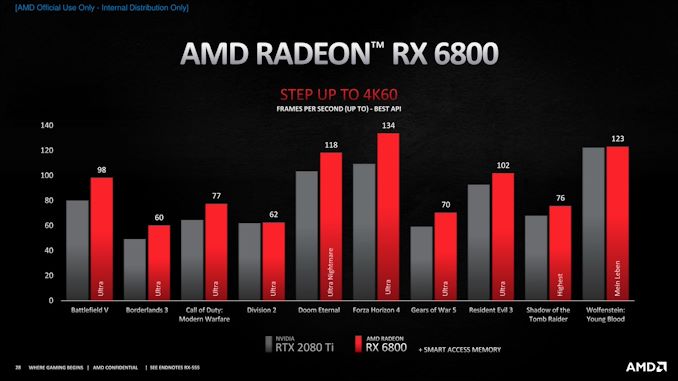
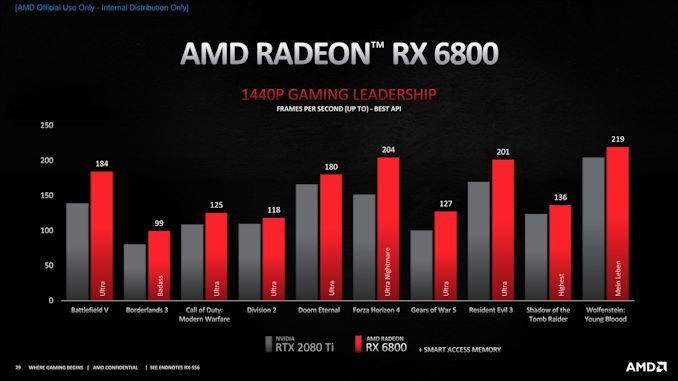
Priced at $579, the RX 6800 is $80 more expensive than the RTX 3070, which retails for $499. But the benchmarks show some real gains compared to the RTX 3070 in some titles, and that along with the extra 8GB memory might be worth the extra money. As always, wait for unbiased third-party reviews before making such decisions.
Radeon RX 6800 XT
- 72 Compute Units & Ray accelerators
- 16GB of 256-bit GDDR6 (512 GB/s bandwidth)
- 2015Mhz Game Clock / 2250Mhz Boost Clock
- 128MB Infinity Cache
- 750W Recommended PSU
- 300W TDP
- $649
The RX 6800XT is the middle man in the stack. Featuring a slightly cut down Navi 21 die and the same memory and Infinity Cache configuration as it’s siblings, AMD is positioning this as their mainstream flagship GPU, meant to compete with the RTX 3080. The benchmarks they’ve shown suggest exactly that, with the card matching or slightly beating the RTX 3080 at 4K and 1440p.
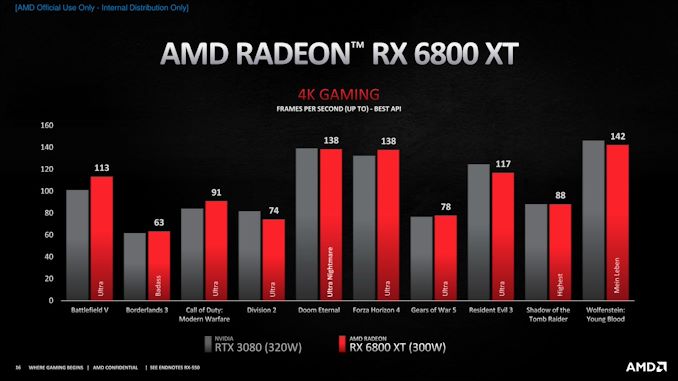
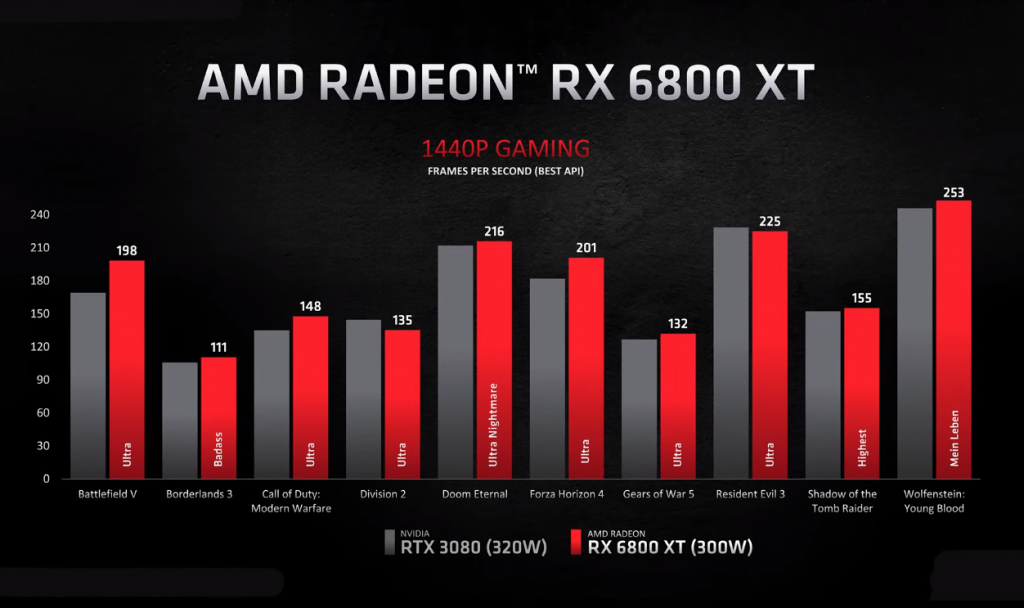
Priced at $649, the RX 6800 XT undercuts the RTX 3080 by $50. The card seems to give similar performance in traditional rasterization-based games, at a lower TDP and cost. This is easily the best value proposition in the stack.
Radeon RX 6900 XT
- 80 Compute Units & Ray accelerators
- 16GB of 256-bit GDDR6 (512 GB/s bandwidth)
- 2015Mhz Game Clock / 2250Mhz Boost Clock
- 128MB Infinity Cache
- 850W Recommended PSU
- 300W TDP
- $999
Lisa Su got the privilege of announcing something most people didn’t see coming — an RTX 3090 competitor. The RX 6900 XT features the full Navi 21 die, with 80CUs. It features the same memory and Infinity Cache configurations as its siblings, which is slightly disappointing considering it’s the most powerful card in the lineup.
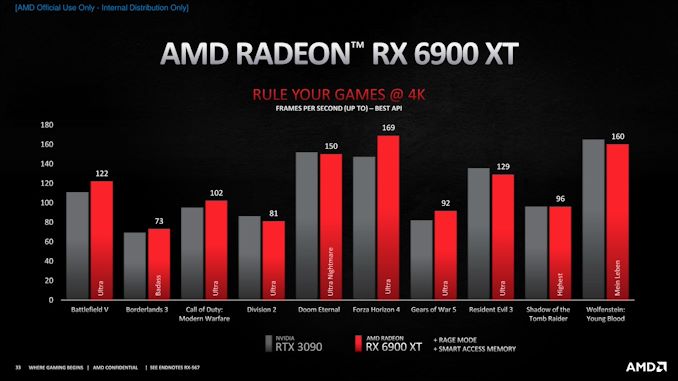
Priced at $999, the RX 6900 XT is great value compared to the RTX 3090 as it offers much of the same performance compared to the RTX 3090 for $500 less. It might have 8GB less memory compared to the Nvidia offering, but AMD is targeting this squarely at gaming, so 16GB is plenty. Considering the rather small performance increase v/s the RX 6800 XT, this card should’ve been priced no more than $799, but AMD is just taking advantage of the high pricing that Nvidia has put for the RTX 3090 to make bigger margins.
*Rage Mode & Smart Memory Access
The keen-eyed among you must’ve noticed the “Rage Mode” and “Smart Memory Access” asterisks in the benchmarks. These are two features that enable the Radeon cards to perform better. Rage Mode is pretty simple, it’s just a one-click software overclocking button that nets you anywhere from 1-2% extra performance.
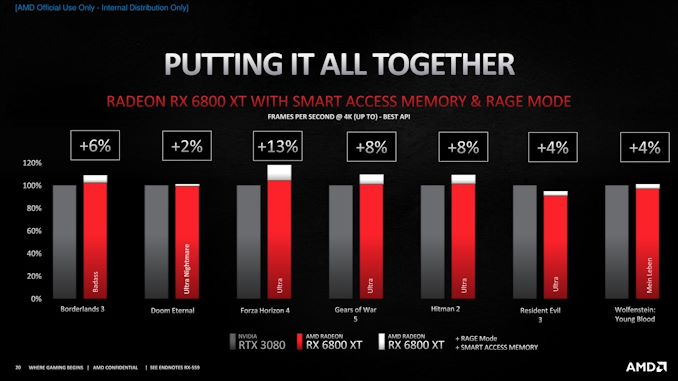
Smart Memory Access is much more important. Basically, if you use a Radeon RX 6000-series card with a Ryzen 5000-series CPU on a 500-series motherboard, it gives CPU direct access to the full 16GB of the GPU’s VRAM, avoiding the usual 256MB limitation between CPUs and PCIe devices.
This could be a game-changer once more game developers start taking full advantage of the feature, and give a full-AMD based PC noticeably better performance than an Intel + Nvidia / Radeon configuration. Smart Memory Access gives anywhere from 3-12% better performance.
Even with those two features disabled, the cards should still perform close to the RTX 3000 series they’re competing against.
But where are the ray-tracing benchmarks?
Many enthusiasts watching the presentation were rather appalled by the lack of any ray-tracing benchmarks v/s the RTX 3000 cards, and that was completely intentional. Leaks from various sources confirm that the Ray-tracing performance of RDNA 2 is slightly better than RTX 2000 series, but nowhere close to RTX 3000. Showing those benchmarks would be like AMD shooting themselves in the foot, so we’ll have to wait for independent testing, and hope RDNA 3 will fare much better in this aspect.
Is the RX 6000 series bad for ray tracing? Certainly not. If it performs like the RTX 2080 / 2080 Ti, it will still be a decent experience, but nowhere near the performance of the RTX 3000 series. So if you want the best ray-tracing performance, you’d still have to turn to team green — that is to play the handful of games that support it.
One advantage of RDNA 2’s ray-tracing implementation is that it uses Microsoft’s DXR, versus Nvidia’s proprietary RTX technology. This means that the cards can run any game which supported ray-tracing, and can gain access to a wider variety of games that uses DXR in the future, v/s just RTX.
Software Features
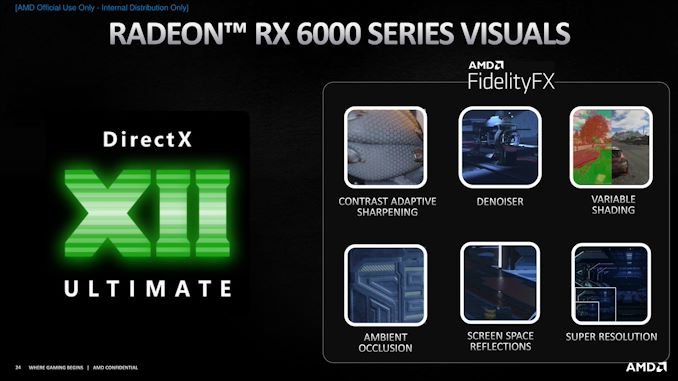
AMD’s suite of FidelityFX features makes an appearance on the RX 6000 series as well. It features contrast based sharpening, a ray-tracing denoiser, variable shading, optimized ambient occlusion, and Super Resolution. Super Resolution seems to be their answer to Nvidia’s DLSS 2.0, which is an upscaling technology used to give more resolution to games without taking a major performance hit. This feature is still in development, but leaks point to a release by the end of december.
Then there’s some latency-reducing features like Radeon Boost, but that’s about it. This shows AMD’s rather lackluster software feature set. Nvidia has unique and well-performing features like Shadowplay and Broadcast, which just isn’t rivalled by anything AMD offers right now. Since they’ve largely closed the performance deficit, it’s time Radeon focuses on the software set, as that could be the factor which makes people choose the competitor when seeing two GPUs which perform the same and are similarly priced.
Radeon is finally relevant again
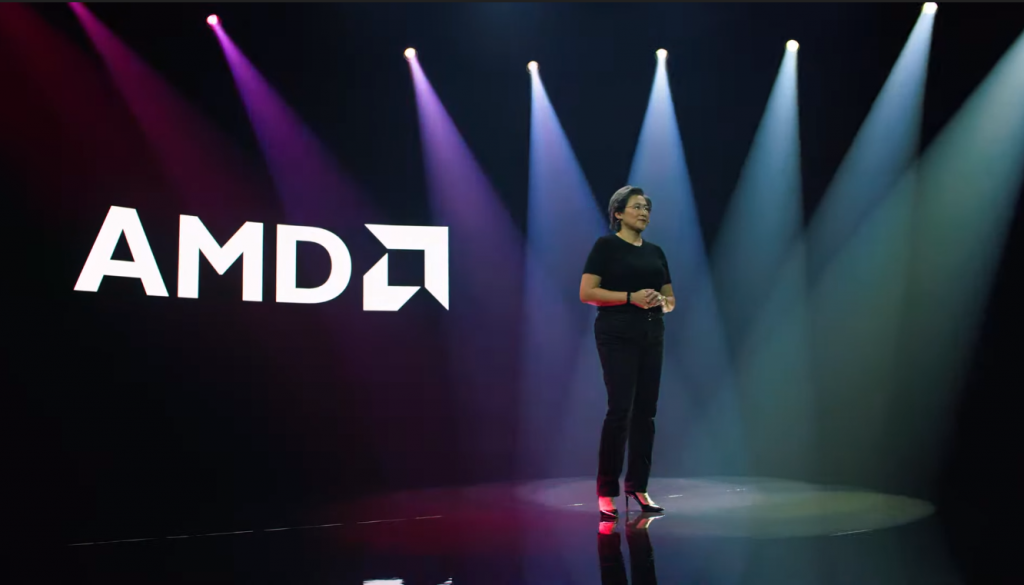
Just like what she did with Ryzen, Dr. Lisa Su is successfully turning around the broken ship that was Radeon. Three years ago, I wouldn’t have even dreamt of Radeon competing in the high-performance sector, and yet here we are. This is like Zen 2, when Ryzen finally reached performance parity with Intel chips. With better ray-tracing and software sets, RDNA 3 might be the Zen 3 moment that could rock the whole GPU industry.
The next question is obviously Nvidia’s response. The RTX 3070 is still pretty safe, but Nvidia needs to make moves on the 3080 and 3090. The rumored 16GB and 20GB variants of the RTX 3070/80 appear to have been canceled, but leakers have recently spotted two new GA102 SKUs, meaning a potential RTX 3070/80 Ti could be in the works to combat the new Radeon cards. This makes the lineup even more confusing and is a painful blow to early RTX 3000 series adopters, but that’s just how business works. Also, this isn’t really their main issue, rather that there’s no stock for the cards they already launched. Currently plagued with shortages, nobody can get their hands on an RTX 3000 series card (for now).
If AMD continued to refine their drivers and give us stable drivers on launch day, and have a decent amount of stock for the 6800 series, they automatically win. AIB cards have been seen with boost clocks as high as 2.5Ghz, which is pretty insane and shows the progress they’ve made in frequency scaling. People who are desperate to get RTX 3000 series level performance will buy these in hoards, taking away a lot of sales from Nvidia. I sincerely hope this launch goes well, as I’m sick and tired of seeing Radeon be the underperforming mess it was before.
Availability
- Ryzen 5000 series: November 5th
- Radeon RX 6800 series: November 18th
- Radeon RX 6900 XT: December 8th
4K AMD ampere big navi nvidia PC gaming radeon ray tracing rdna2 rtx 3070 rtx 3080 rtx 3090 rx 6000 rx 6800 rx 6800xt rx 6900xt
Last modified: October 29, 2020





